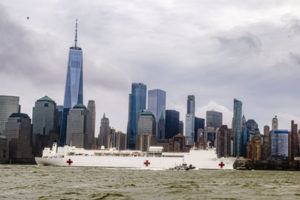
The hospital ship USNS Comfort departs New York harbor after treating patients in New York and New Jersey. By the end of April, more than 62,200 DoD personnel were involved in relief efforts in every state. Navy photo by Mass Communication Specialist 3rd Class Brendan Fitzgerald
WASHINGTON—Divide and conquer. The DoD is taking a new tack on the old advice, dividing the huge demand for support across the country among the services and related agencies in an effort to surmount this wave of the COVID-19 pandemic.
By the end of April, more than 62,200 DoD personnel were involved in relief efforts in every state. Units were working on 62 mission assignments for the Federal Emergency Management Agency, and DoD medical staff provided assistance in 22 hospitals, Army leadership said in a press briefing.
After a month at Pier 90 in New York City helping to relieve pressure on local hospitals from the huge influx of COVID-19 patients, the USNS Comfort departed the city, returning to Norfolk to prepare for its next mission.
“This amazing crew of over 1,200 people treated 182 patients, of which approximately 70 percent were afflicted by COVID-19,” said Capt. Patrick Amersbach, commanding officer of the Comfort’s Medical Treatment Facility.
The USNS Mercy remained in Los Angeles, where it has been since March 31. The ship continued to treat non-virus patients onboard, while 40 sailors from the Mercy moved into the city to assist hospitals fighting COVID-19 directly. Two Navy expeditionary medical facility detachments were also supporting hospitals in Texas, Louisiana, and New York.
“Fourteen of 15 urban augmentation task forces remained deployed” as of April 30, said Army Chief of Staff Gen. James C. McConville. The teams were distributed throughout New York, New Jersey, Connecticut, Massachusetts, and Pennsylvania. Overall, the U.S. Northern Command had embedded military medical providers at 22 hospitals.
The Army Corps of Engineers constructed 22 alternate care facilities (ACF) to provide surge capacity in Alaska, California, Florida, Illinois, Maryland, Michigan, Missouri, New Jersey, New Mexico, New York, and Wisconsin as well as the District of Columbia. The projects, valued at $1.8 billion, required the efforts of 15,000 personnel and direct deployment of 1,495.
In addition, the Corps built a 40-bed ACF in Shiprock, NM, and expected to complete construction of a 50-bed alternate care facility in Chinle, Arizona for the Navajo Nation in early May. Both will provide urgently needed capacity within the Navajo Nation.
More than 45,000 members of the National Guard provided assistance to the states, with every governor having called up units. In Massachusetts, 1,800 were activated to deliver personal protective equipment to first responders, assist in food banks and testing sites, and help in hospitals. In Oklahoma, the Guard provided critical assistance to keep two large food banks operating, while in New Hampshire, the National Guard distributed 100 tons of PPE to first responders and healthcare workers.
The Rhode Island National Guard delivered and collected hundreds of COVID-19 testing kits. In North Carolina, guardsmen logged almost 49,000 miles delivering PPE to 80 counties. In Washington, the National Guard provided more than 800,000 meals and 6.4 million pounds of food in support of food banks and tested more than 1,300 people across the state.
The West Virginia National Guard helped the state prepare for the next steps in the pandemic, providing training for safe reopening for 700 retailers and decontamination of long-term care facilities.
Continue Reading this Article

